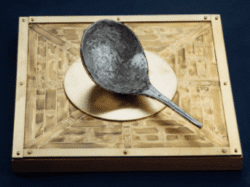Compass, China, 220 BCE
Earliest records show a spoon shaped compass made of lodestone or magnetite ore, referred to as a “South-pointer” dating back to sometime during the Han Dynasty (2nd century BCE to 2nd century CE). The spoon-shaped instrument was placed on a cast bronze plate called a “heaven-plate” or diviner’s board that had the eight trigrams (Pa Gua) of the I Ching, as well as the 24 directions (based on the constellations), and the 28 lunar mansions (based on the constellations dividing the Equator) . Often, the Big Dipper (Great Bear) was drawn within the center disc. The square symbolized earth and the circular disc symbolized heaven. Upon these were inscribed the azimuthal points relating to the constellations. Its primary use was that of geomancy (prognostication) to determine the best location and time for such things as burials. In a culture that placed extreme importance on reverence for ancestors, this remained an important tool well into the 19th century. Even in modern times there are those who use this divination concepts of Feng Shui (literally, of wind and water) for locating buildings or fortuitous times and locations for almost any enterprise. There is a story that the first Chin emperor used the divining board and compass in court to affirm his right to the throne. Primarily, the compass was used for geomancy for a long time before it was used for navigation
Method of Construction
by Susan Silverman AC
HOW I MADE THIS MODEL I had a lot of trouble locating a piece of magnetite large enough to make a spoon. I also learned from people who worked with stone that magnetite is extremely difficult to work. It is all the more amazing that the Chinese were able to work with such a stone. Consequently to make this model, I decided to use sheet steel, heated and hammered to form a spoon shape. A handle was welded on and then tapered to create a balance point (many thanks to Trash Can Forge and Scott Cunningham of Hancock, NH) . It was then magnetized with a device at the Smith Physics lab. The plate and strips were cut from a sheet of brass, then the symbols were painted on the surface with nailpolish (many thanks to Xiaoching Chi). The plate was then etched in acid to make the characters stand out. The whole was assembled and sprayed with lacquer to keep the brass from tarnishing. It was difficult to achieve a sufficient magnetic strength to overcome the friction of the plate, thus the device has some limitations as a compass.
SOURCE: Needham, Joseph, Science and Civilization in China, Vol. 4, part 1:Physics, Cambridge Univ. Press, 1962.
Ancient Chinese alchemists realized that the magnetite ore would point towards a magnetic north. Their understanding was not total, since they thought that there were north pointers and south pointers. “The lodestone follows a maternal principle. The needle is struck out from the iron (originally a stone) and the nature of mother and son is that each influences the other, and they communicate together. The nature of the needle is to return to its original completeness. As its body is very light and straight, it must indicate straight lines. It responds to the chhi by orientation, being central to the earth and deviating in various directions. To the south it points to the Hsuan-Yuan constellation, hence to the hsiu Hsing and therefore to the hsiu Hsu in the north, along the axis Ting-Kuei. The yearly differences follow the elliptic, and all such phenomena can be understood.” (from Master Kuan’s Geomantic Instructor), 8th century CE
By the time of the T’ang dynasty (7-8th century CE) , Chinese scholars had devised a way to magnetize iron needles, by rubbing them with magnetite, and then suspending them in water (early 11th century). They also had observed that needles cooled from red heat and held in the north-south orientation (the earth’s axis) would become magnetic. These more refined needle compasses could then be floated in water (wet compass), placed upon a pointed shaft (dry compass) or suspended from a silk thread. Consequently, they were much more useful for navigation purposes since they were now much more portable (and smaller). During the Sung dynasty (1000 CE) many trading ships were then able to sail as far as Saudi Arabia without getting lost. The plate was converted to a bowl, and retained the markings of the heaven’s plate around its circumference, in a simplified form. The inner circle had the eight trigrams and the outer circle the 24 directions (based on azimuth points).




